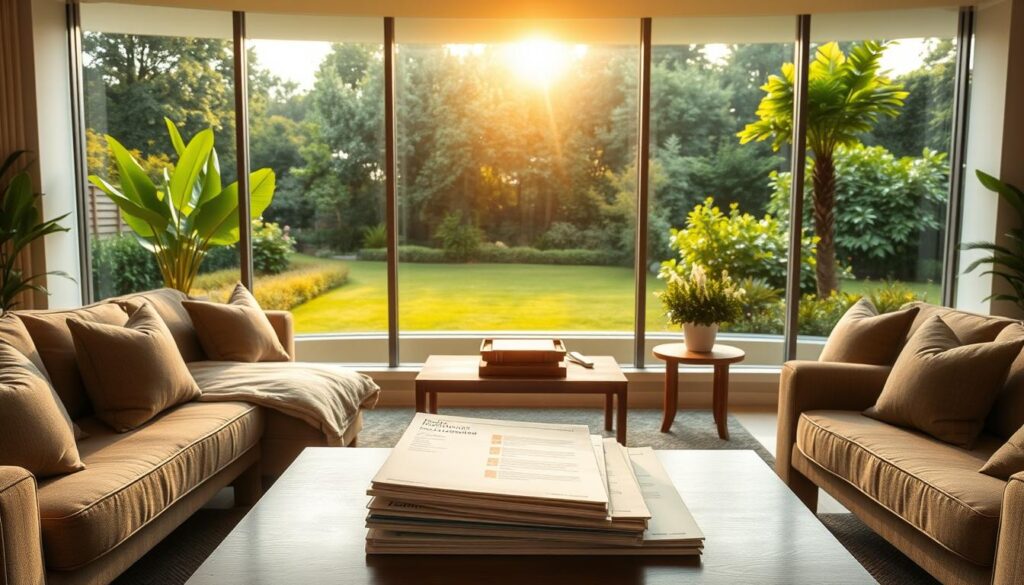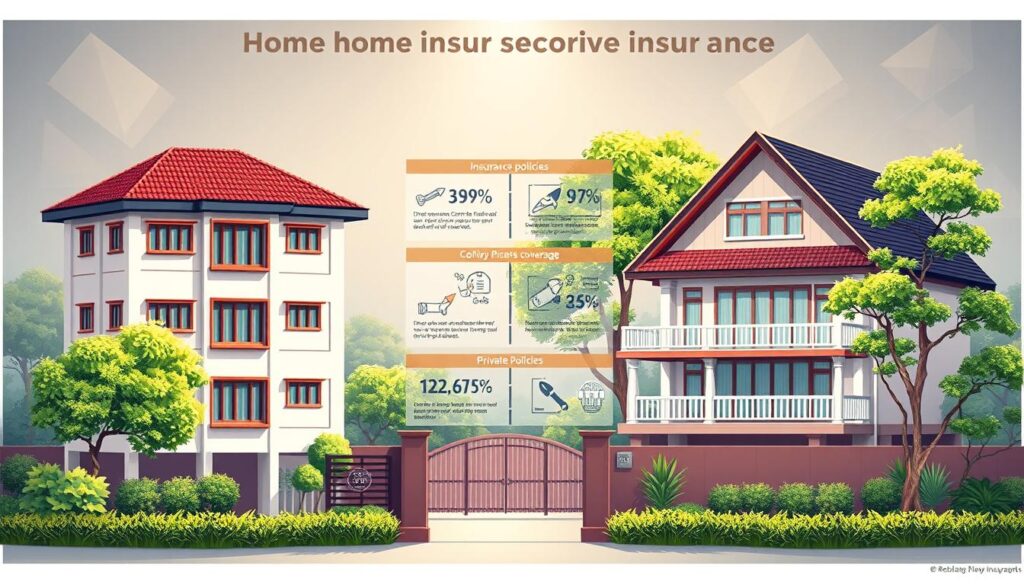Finding the right property protection can be a challenge. With so many options available, it’s essential to compare plans that suit your needs. In Singapore, several providers stand out for their affordability, unique features, and comprehensive coverage.
For instance, FWD offers a budget-friendly option starting at just S$39 per year. Their plan includes zero upfront claims and workmanship guarantees, making it a practical choice for many. On the other hand, AIG provides worldwide personal accident coverage and advanced leak detection services, adding extra layers of security.
Great Eastern’s Superior Plan is another excellent option, especially for eco-conscious individuals. It includes green appliance coverage and discounts, along with no under-insurance penalties. Premiums across providers range from S$39 to over S$200, depending on factors like property age and location.
When choosing a plan, consider features like 24/7 emergency assistance and customizable coverage. These can make a significant difference in ensuring your property is well-protected.
Key Takeaways
- Compare plans from top providers to find the right fit for your needs.
- FWD offers affordable options starting at S$39 per year with no upfront claims.
- AIG includes worldwide personal accident coverage and leak detection services.
- Great Eastern’s Superior Plan features eco-friendly discounts and no under-insurance penalties.
- Premiums vary based on factors like property age and location.
- Look for 24/7 emergency assistance as a key differentiator.
What is Home Insurance in Singapore?
Understanding property protection is crucial for safeguarding your residence. In Singapore, home insurance serves as a financial safety net against unexpected events like disasters, theft, or accidents. It ensures that your property and belongings are covered, giving you peace of mind.
Definition and Purpose
Home insurance is a policy that provides triple coverage: building structure, contents, and personal liability. The building structure includes walls, roofs, and permanent fixtures, while contents cover furniture, electronics, and other personal items. Liability protection shields you from legal claims if someone gets injured on your property.
Unlike HDB’s mandatory fire insurance, which only covers structural repairs, comprehensive home insurance offers broader protection. For example, a burst pipe damaging your flooring would be covered, but an earthquake would require a specific policy.
Why Home Insurance is Essential in Singapore
Singapore’s dense housing and tropical climate pose unique risks. Monsoon floods and fires spreading from neighboring properties are common concerns. In 2024, 37% of claims were for water damage, while 28% involved theft cases in private properties.
“Being uninsured can lead to significant financial strain. The average out-of-pocket repair cost in Singapore is S$15,000.”
Having the right coverage ensures you’re prepared for these risks. It not only protects your property but also safeguards your finances from unexpected expenses.
Key Benefits of Home Insurance
Securing your property against unexpected events is a smart move. With the right coverage, you can safeguard your residence and belongings while enjoying added benefits. Here’s how property protection can make a difference in your life.
Financial Protection
One of the primary advantages is financial protection. Policies often include up to S$500,000 for building structures and S$50,000 for contents replacement. This ensures you’re covered for significant damage or loss without bearing hefty costs.
For example, a burst pipe or fire can lead to expensive repairs. With the right plan, these expenses are handled, saving you from financial strain.
Peace of Mind
Knowing your property is protected brings peace of mind. Many plans offer 24/7 emergency assistance, including locksmith and pest control services with a 2-hour response time. This quick support minimizes disruptions and keeps your residence secure.
In case of major incidents, some policies even cover temporary relocation costs, such as S$350 per day for hotel stays.
Additional Services
Beyond basic coverage, many providers offer extra perks. These include legal fee coverage for neighbor disputes over property damage and free electrician callouts, saving you up to S$180 per visit.
- Multi-policy discounts when bundling with car or life plans.
- COVID-era additions like disinfection services coverage.
- Workmanship guarantees for repairs, ensuring quality work.
These benefits make property protection not just a necessity but a valuable investment.
What Does Home Insurance Cover?
Knowing what your property protection plan includes is essential for peace of mind. A good plan should clearly outline what’s covered, helping you avoid unexpected expenses. Let’s break down the key areas of coverage to ensure you’re fully protected.

Building Structure
Your plan typically covers the building structure, including walls, roofs, and permanent fixtures. For HDB flats, this includes walls and floors, while private properties may extend to foundations and swimming pools. Some plans even cover built-in wardrobes and kitchen cabinets, with limits typically under S$200,000.
Unique inclusions like debris removal and conservancy charge payments are also available with certain providers. Always check for exclusions, such as pre-existing structural issues, to avoid surprises.
Home Contents
Your personal belongings, or contents, are another critical part of your plan. This includes furniture, electronics, and even green appliances. However, sub-limits often apply. For example, jewelry may be covered up to 5% of the total coverage, while electronics might have a cap of S$1,500 per item.
Special cases like bicycles are usually covered only if stolen from inside the premises. Providers like Income also include mirrors and fixed glass in their plans.
Personal Liability
Personal liability protects you from legal claims if someone gets injured on your property. For instance, if a neighbor slips and falls, your plan may cover up to S$500,000 for their medical bills. However, tenant vandalism often requires an add-on.
Other exclusions include damage caused by natural disasters like earthquakes. Always review your policy to understand these limits.
- Structural coverage: HDB walls vs. private property foundations.
- Contents specifics: Sub-limits for jewelry and electronics.
- Liability examples: Medical bills from slip-and-fall incidents.
- Exclusions: Tenant vandalism and pre-existing issues.
- Special cases: Bicycles stolen from inside premises.
- Renovation protection: Built-in wardrobes and kitchen cabinets.
- Unique inclusions: Debris removal and conservancy charges.
How Does Home Insurance Work?
Navigating the process of property protection can seem complex, but understanding how it works simplifies decision-making. From premium payments to filing claims, each step ensures your residence is safeguarded against unexpected events. Let’s break down the key aspects to help you make informed choices.

Premium Payments
Your policy begins with premium payments, which are calculated based on factors like property size and location. On average, premiums cost S$0.28 per square foot. Properties near flood zones may see an 18% increase in cost.
Under-insurance is a common issue. For example, if your property is worth S$500,000 but insured for only S$200,000, you’ll bear 60% of the repair costs. Always ensure your coverage matches your property’s value.
Filing a Claim
When damage occurs, filing a claim is your next step. Most insurers require you to report incidents within 72 hours. For theft cases, a police report is mandatory.
Approved claims are typically settled within 14-21 days. However, excess fees may apply. For instance, water damage claims often require a S$100 payment. Keep records and photographs of expensive items to speed up verification.
Policy Terms and Conditions
Understanding your policy terms is crucial. Unapproved Airbnb rentals, for example, can void most claims. Always update your coverage after renovations to avoid gaps in protection.
Here are some key points to remember:
- Property size and location affect premium costs.
- Report incidents within 72 hours for faster claims processing.
- Excess fees like S$100 for water damage may apply.
- Update your policy after major changes to your property.
- Photograph valuable items for smoother claims verification.
Best Home Insurance Plans in Singapore
Choosing the right protection for your property doesn’t have to be overwhelming. With various plans available, it’s easier to find one that fits your needs. Here’s a look at some of the top options in the market.

FWD Home Insurance
FWD stands out as one of the most affordable insurers, with plans starting at just S$39 per year. Their policies include appliance repair guarantees, ensuring your household items are covered. This makes it a practical choice for budget-conscious individuals.
AIG Homes Essential Plan
AIG is ideal for expats, offering worldwide personal accident coverage. Their plans also include advanced leak detection services, adding an extra layer of security. If you’re looking for global protection, AIG is a strong contender.
Great Eastern’s Great Home Protect Superior Plan
For eco-conscious individuals, Great Eastern offers a 15% green discount. Their Superior Plan includes coverage for green appliances and no under-insurance penalties. It’s a great option for those prioritizing sustainability.
Other notable providers include Income, MSIG, and HL Assurance. Income offers flexible plans with a minimum premium of S$35.64 and includes four emergency callouts. MSIG is perfect for landlords, covering malicious tenant damage. HL Assurance even provides unique pet injury coverage.
When comparing add-ons, consider travel insurance bundles or extended jewelry coverage. These extras can enhance your plan and provide additional peace of mind.
Key Differences Between Home Insurance for HDB Flats and Private Properties
Understanding the distinctions between HDB flats and private properties is key to choosing the right plan. Each type of residence has unique needs, affecting both coverage and cost. Let’s explore these differences to help you make an informed decision.

Coverage Variations
For HDB flats, the focus is often on contents, with an average coverage of S$35,000. This includes furniture, electronics, and personal belongings. Private properties, on the other hand, emphasize structural protection, covering foundations, walls, and even swimming pools.
Renovation limits also differ. HDB flats typically cap renovation coverage at S$50,000, while private properties often exceed S$200,000. Additionally, private property owners may need loss of rent coverage, especially if they’re landlords.
Cost Considerations
The cost of insurance varies significantly. HDB fire insurance ranges from S$4.50 to S$22.50, while private structural coverage averages S$1.20 per S$1,000 insured. On an annual basis, HDB plans cost around S$75, compared to S$420 for landed properties.
Unique risks also affect pricing. Private properties may face garden liability or pool accidents, which aren’t concerns for HDB flats. Conversely, HDB owners should be aware of MCST coverage gaps for interior upgrades.
| Aspect | HDB Flats | Private Properties |
|---|---|---|
| Focus | Contents | Building Structure |
| Renovation Limit | S$50,000 | S$200,000+ |
| Annual Cost | S$75 | S$420 |
For more details on how HDB fire insurance differs from comprehensive plans, check out this comparison guide.
- HDB: Focus on contents with S$35k average coverage.
- Private properties: Structural emphasis with higher renovation limits.
- Cost comparison: S$75/year for HDB vs. S$420/year for landed properties.
- Unique risks: Garden liability for private properties, MCST gaps for HDB.
How HDB Fire Insurance Differs from Home Insurance
HDB fire insurance and comprehensive property protection serve distinct purposes. While both aim to safeguard your residence, their scope and limitations vary significantly. Understanding these differences helps you make informed decisions about your property’s security.
Purpose and Scope
HDB fire insurance is mandatory for those servicing an HDB loan. It primarily covers structural repairs due to fire damage, such as restoring original tiles or walls. However, it excludes renovations, personal belongings, and other incidents like floods or earthquakes.
In contrast, comprehensive plans offer broader coverage, including contents like furniture and electronics, as well as liability protection. For example, if a fire damages marble upgrades or personal items, a separate policy is needed.
Coverage Limitations
One key limitation of HDB fire insurance is its narrow focus. It doesn’t cover non-fire-related incidents or upgrades. For instance, if a flood damages your property, you’ll need additional coverage to handle repairs.
Here’s a quick comparison of key aspects:
- Cost: Mandatory HDB fire insurance costs S$11.05, while comprehensive plans start at S$75+.
- Claims: Fire damage to original HDB tiles is covered, but marble upgrades are not.
- Legal Requirement: HDB fire insurance must be renewed while servicing an HDB loan.
- Disaster Gaps: Floods and earthquakes require separate policies.
- Contents Valuation: A minimum of S$50k coverage is recommended for 4-room flats.
By understanding these differences, you can ensure your property is fully protected against all potential risks.
Things to Consider Before Purchasing Home Insurance in Singapore
Making informed decisions about property protection requires careful consideration of your unique needs. Whether you’re a first-time buyer or looking to switch plans, understanding key factors ensures you get the right coverage for your residence.
Evaluating Your Coverage Needs
Start by assessing your property’s requirements. Use the formula: (Square Footage × S$200) + Contents Value. This helps estimate the total cost of replacing your belongings and structural repairs.
For heritage homes, specialist valuations are often necessary. These properties may require unique coverage due to their historical significance and construction materials.
Comparing Policy Options
Not all policies are created equal. Use tools like SingSaver’s comparison matrix or create a DIY spreadsheet to evaluate different options. Look for plans that offer flexibility and additional perks.
Here’s a quick comparison of popular tools:
| Tool | Features | Best For |
|---|---|---|
| SingSaver Matrix | Side-by-side comparisons, user reviews | Quick evaluations |
| DIY Spreadsheet | Customizable, detailed analysis | In-depth research |
Timing also matters. Renewing during Q4 promotions can save you up to 20% on premiums.
Understanding Terms and Conditions
Always read the fine print. Watch out for depreciation clauses and paired risk requirements, which can limit your coverage. For example, some policies may exclude water damage if it’s not paired with fire protection.
Keep documentation like renovation receipts and photos of valuable items. These can speed up claims processing and ensure accurate valuations.
Expert tip: Schedule yearly reviews with insurance brokers to keep your plan up-to-date with your evolving needs.
Factors to Consider When Choosing the Best Home Insurance Singapore
Selecting the right plan for your property involves evaluating several key factors. From cost to coverage and customer support, each aspect plays a crucial role in ensuring your residence is well-protected.
Cost of Premiums
Price is often a deciding factor when choosing a policy. Premiums typically range from S$0.50 to S$2.00 per S$1,000 of coverage. For example, a property valued at S$500,000 could cost between S$250 and S$1,000 annually.
Providers like FWD offer competitive rates starting at S$39 per year. Keep an eye out for promotions, as first-year discounts of up to 30% are common.
Coverage Extent
Understanding the scope of your coverage is essential. Look for plans that include alternative accommodation and emergency repairs. These features ensure you’re not left stranded in case of major incidents.
For instance, some policies cover temporary relocation costs, such as S$350 per day for hotel stays. Others include workmanship guarantees for repairs, ensuring quality service.
Customer Service Reputation
Customer support can make or break your experience. FWD boasts a 4.8/5 ClaimSatisfaction rating, well above the industry average of 4.2. Look for insurers with 24/7 hotline availability and multilingual support.
“FWD’s high ClaimSatisfaction rating reflects their commitment to customer care.”
Digital features like apps for photo submissions also streamline the claims process, making it more convenient for policyholders.
| Factor | Details |
|---|---|
| Cost | S$0.50-S$2.00 per S$1,000 coverage |
| Coverage | Alternative accommodation, emergency repairs |
| Customer Service | 24/7 hotline, multilingual support |
When evaluating options, consider financial stability. AM Best ratings provide insights into an insurers reliability. Customization options, like Income’s à la carte add-ons, also allow you to tailor your plan to your needs.
Top Tips for Maximizing Your Home Insurance Benefits
Getting the most out of your property protection plan requires smart strategies. By understanding your policy and leveraging its features, you can ensure better coverage and peace of mind. Here are some practical tips to help you make the most of your plan.
Regular Policy Reviews
Your insurance needs can change over time. After major life events like renovations or new purchases over S$5,000, it’s a good idea to review your policy. This ensures your coverage aligns with your current situation.
For example, upgrading your kitchen or adding smart home devices may require adjustments to your plan. Regular reviews also help you identify gaps in coverage and take advantage of loyalty perks like no-claim discounts up to 25%.
Understanding Exclusions
Every policy has exclusions, and knowing them can prevent surprises during a claim. Common exclusions include termite damage, wear and tear, and war risks. Always read the fine print to understand what’s not covered.
If you’re unsure, ask your provider for a detailed exclusion checklist. This clarity helps you prepare for potential risks and avoid unexpected expenses.
Utilizing Additional Services
Many insurance providers offer extra services that can enhance your plan. For instance, Income’s free 24/7 assistance handles 87% of plumbing emergencies. Using these services can save you time and money.
Other perks include free annual pest control before the monsoon season and cloud inventory tools for documenting your belongings. Take advantage of these offerings to maximize your coverage.
| Tip | Action |
|---|---|
| Review Triggers | After renovations or new purchases over S$5k |
| Exclusion Checklist | Termite damage, wear & tear, war risks |
| Service Hacks | Use free annual pest control before monsoon |
| Documentation | Cloud inventory with video walkthroughs |
| Claims Boosters | Immediate incident reporting via insurer apps |
| Upgrade Path | Switch from HDB to private coverage when needed |
| Loyalty Perks | No-claim discounts up to 25% |
By following these tips, you can ensure your policy works harder for you. Regular reviews, understanding exclusions, and utilizing additional services are key to maximizing your insurance benefits.
Conclusion
Securing your residence with the right plan ensures peace of mind and financial safety. Providers like FWD offer budget-friendly options, while AIG caters to expats with global coverage. Income stands out for its customizable plans, making it easy to tailor your policy to your needs.
Proper coverage can save you an average of S$18,000 in unexpected expenses. For complete protection, consider combining HDB fire insurance with a comprehensive plan. This ensures all potential risks are addressed.
Use tools like SingSaver’s comparison feature to get instant quotes and find the best fit. Rising trends, such as climate change riders, are gaining popularity, with a 15% uptake in recent years. Staying updated with these options ensures your plan remains relevant.
Finally, schedule annual reviews to align your coverage with inflation and any changes to your property. This proactive approach guarantees your residence is always well-protected.

